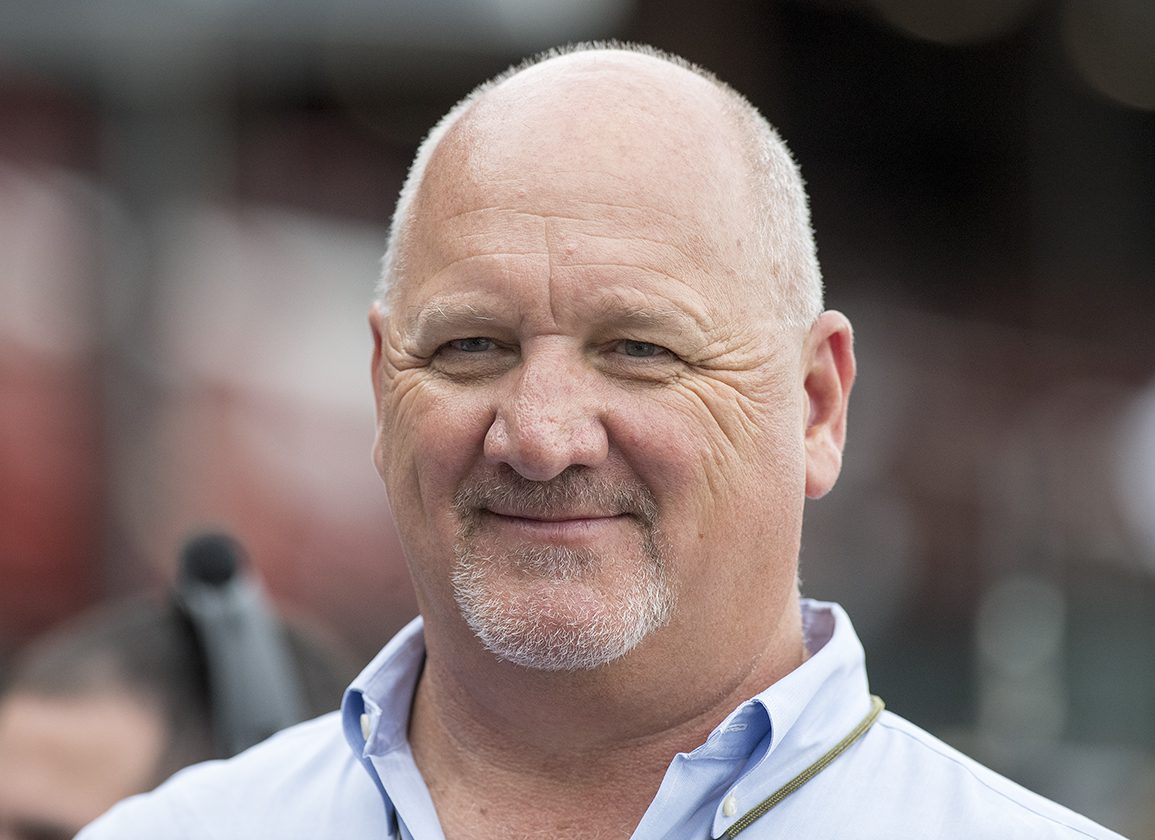By Chris McGrath
He's a rebel with a Causeway. But he is a rebel, all the same; or a maverick, at least; an outlier. Certainly we can't expect everyone to train horses like Kenny McPeek, nor indeed to buy them the same way. Apart from anything else, most people simply wouldn't be good enough.
McPeek's 10 millionaires to date have been sired by the likes of Cuvee, Louis Quatorze, Daredevil, Hit It a Bomb and Tejano–and he signed for most of them himself. As one who marches to his own drum, his style obviously wouldn't work for everyone. Think outside the box, and you'll have to manage without the many investors who feel nervous straying beyond the comforting confines of convention. They will seek sanctuary in the kind of strike rates available with trainers who start horses about as often as Halley does his Comet. Nonetheless, there are some pretty universal lessons to be drawn from the success of Classic Causeway (Giant's Causeway) in the big race at Belmont last weekend, just two weeks after his barn debut.
Because if McPeek is too much of a one-off to be categorized simply as “old school”, there's no doubting the throwback element in Classic Causeway himself, famously one of just three foals from the final crop of the Iron Horse. And if McPeek is to some degree a victim of his own success, in that you tend not to be sent too many yards of silk if you can contrive such fine purses of a relative sow's ear, let's not forget that one of the world's most lavishly resourced stables is supervised by another who believes that Thoroughbreds actually thrive on competition.
Click the play button below to listen to this week's episode of This Side Up.
Very few elite trainers in Europe, nevermind America, would have drawn out the reserves of Giant's Causeway as boldly as Aidan O'Brien. Already a Group 1 winner at two, Giant's Causeway started his sophomore campaign by fending off a battle-hardened, race-fit 6-year-old in April. Between May 6 and Sept. 23, he then finished first or second in eight Group 1 races, constantly switching distance. After that, as nobody will need reminding, he shipped to run the dirt monster Tiznow to a neck in the GI Breeders' Cup Classic.
We're talking about an exceptional specimen here, clearly, but O'Brien has always operated on the basis that his patrons at Coolmore require reliable exposure of genes they might wish to replicate. And like his mentor Jim Bolger, who last year ran 2,000 Guineas winner Poetic Flare (Ire) (Dawn Approach {Ire}) in two other Classics over the next three weeks, he additionally believes that maturing horses flourish for racetrack experience. Peeping Fawn (Danehill) had an aristocratic pedigree, nothing to prove there, but O'Brien still worked her like a stevedore. She had already been beaten three times in April when breaking her maiden on May 16. Eleven days later she ran third in a Classic over a mile. FIVE days later she was beaten half a length in the G1 Oaks at Epsom, over a mile and a half. Did she recoil from this dazing sequence of examinations? She did not. Instead, going up and down in distance every time, she won four Group 1 prizes in 54 days.
As it happens, Peeping Fawn has proved a fairly disappointing producer, albeit unlucky that her best daughter derailed. Giant's Causeway, however, has emulated his sire Storm Cat as a hugely important crossover influence. That's unsurprising, after his own slick transfer to the American racing environment, and he stands as a withering rebuke to the prescriptive approach we see, both sides of the water, to racing surfaces. He came up with a worthy heir in Europe at the first attempt in Shamardal, whose maternal pedigree was shaded very green, but has book-ended his career with an outstanding young Kentucky sire in Not This Time, whose own family obviously contains no less resonant dirt names.
Interestingly, Classic Causeway is out of a mare by Thunder Gulch, whose breeder Peter Brant has always been so far-sighted in this regard. Thunder Gulch himself, of course, combined a sire who had won benchmark races for the recycling of dirt speed–the GI Hopeful S., the GI Met Mile H. twice, the GI Breeders' Cup Sprint–with a turf mare whose dam had finished second in the G1 Gold Cup at Ascot over two and a half miles.
Most horses are more versatile than we will ever know. We should always start with the animal in front of us, and how it all fits together, rather than meekly obey herd presumptions. Sure enough, having only recently taken Classic Causeway into his care (after Brian Lynch laid some excellent foundations), McPeek urged a switch to turf because “the horse has a foot like a pancake”.
But often it's simply a question of opportunity. It was only the search for outcross blood at Coolmore, for instance, that allowed War Front and Scat Daddy to penetrate European myopia as coveted “turf” influences. And while John Magnier and his partners seem to be doing pretty well without my advice, I will just dust off my plea that they might indulge European mare owners by allowing American Pharoah at least one spring in Co Tipperary. (Especially as I keep reading that the home farm may apparently be a little short of fresh blood just now.)
After last week's glimpse of how a more wholesome future might look, we revert to business as usual in the first Grade I of the Saratoga meet, with Chad Brown having to generate his own competition on grass. In fact, just one other American trainer has mustered a runner in the Diana S. It's striking, however, that most exciting member of the field is also the only one bred in America.
Bleecker Street was hardly a blatant turf prospect the day Brant purchased her as a yearling, down the road at Fasig-Tipton, but her sire Quality Road has a very flexible genetic background. (Just his first two dams will tell you that, as daughters of Strawberry Road and Alydar–and there's plenty more when you get down in the wheat.) Even Chad Brown has been prepared to start Bleecker Street in four graded stakes already this year, so presumably McPeek or O'Brien would by this stage have sent her to the moon and back.
Just as surface aptitude tends to be self-fulfilling, so you have to wonder to what extent pessimism about the constitution of the modern racehorse would stand up to horsemen actually going out there and testing it properly. But if we won't train them like McPeek, then the least we can do is breed them like Classic Causeway. As it was, no farm in Europe or Kentucky offered Bolger enough for Poetic Flare. And that's why, when so much of our commercial glister washes out the moment a horse has to break sweat, it will be the Japanese who end up with the horses of iron.
Not a subscriber? Click here to sign up for the daily PDF or alerts.








